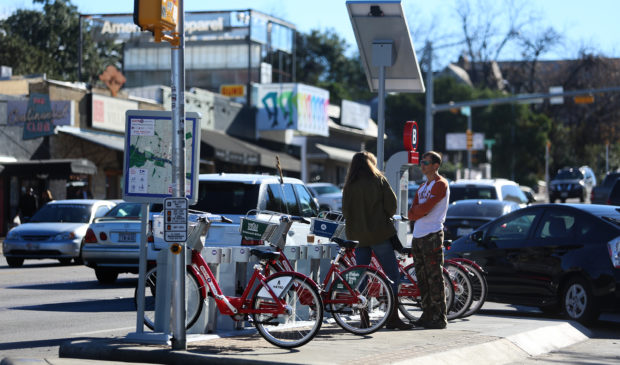Newsletter Signup
The Austin Monitor thanks its sponsors. Become one.
Most Popular Stories
- Austin opens new affordable housing development in Southeast Austin
- Landmark commission says goodbye to Nau’s Enfield Drug
- After a decline last year, Travis County homeowners should expect a return to rising property taxes
- ZAP Commission forwards recommendation allowing some commercial uses in residential zones
- Ryan Alter and colleagues propose revision of boards and commissions
-
Discover News By District

B-cycle is expanding. So why are all the new stations near downtown?
Thursday, July 20, 2017 by Audrey McGlinchy, KUT
B-cycle, Austin’s bike-share system, recently added three new stations as part of an 18-station build up over the next 18 months. All of these new stations will be close to or in downtown, adding to the company’s existing 51 docks.
An expansion might seem like an opportunity to finally build a station outside of B-cycle’s limited coverage – once you cross I-35, bike-share stations do not exist north of East 11th Street. Go south of the river, and B-cycle stations peter out by Elizabeth Street.
Sophia Benner, who chairs the city of Austin’s Bicycle Advisory Council, said she’s heard this question many times: “Why are they expanding in the direction they are and why aren’t they going a little farther?”
The answer, she said, lies in the required number and closeness of stations to ensure that bike-share is a real option for people who want to use it.
“The nature of that business is such that their expansion has to continue the same amount of station density,” said Benner. “It’s not very easy for them to just locate a single station, or even just a couple stations, several miles away from the rest of the herd. It’s not very viable for that business.”
According to a report from the National Association of City Transportation Officials, ridership depends upon the density of stations. And that’s because bike-share is about convenience.
“The trick with bike-share systems is always sort of doing the balance between making sure that you have stations close enough together so that it’s easy for people to use and also making sure that you have a system that’s big enough so that it can take you enough places so that people want to use it,” said Kate Fillin-Yeh, director of strategy at NACTO.
She said figuring out how to build a successful bike-share system is not about people’s willingness to bike.
“It really is actually about how far someone is willing to walk to get to a bicycle,” said Fillin-Yeh. That distance is about a quarter-mile.
“We’re trying to create an interconnected network where it’s really easy to jump on a bike,” said Elliott McFadden, the executive director of Austin B-cycle. “If people have to walk long enough to get to a bike, they’re going to use some other form of transportation.”
NACTO has said 28 stations per square mile is an ideal station density. Austin has only an average of nine stations per square mile. According to 2015 data, New York City’s bike-share, Citi Bike, had an average of 23 stations per square mile, while Denver’s bike-share system had an average of five stations per square mile.
McFadden said as they expand geographically, they must maintain a certain level of density.
“So you have this core system that’s built to make the system successful and get it off the ground and then we grow out to neighborhoods as there’s demand,” said McFadden.
The latest B-cycle expansion will cost roughly $800,000, and funding, in part, is coming from a Federal Highway Administration grant.
This story was produced as part of the Austin Monitor’s reporting partnership with KUT. Photo by Jorge Sanhueza-Lyon/KUT News.
The Austin Monitor’s work is made possible by donations from the community. Though our reporting covers donors from time to time, we are careful to keep business and editorial efforts separate while maintaining transparency. A complete list of donors is available here, and our code of ethics is explained here.
You're a community leader
And we’re honored you look to us for serious, in-depth news. You know a strong community needs local and dedicated watchdog reporting. We’re here for you and that won’t change. Now will you take the powerful next step and support our nonprofit news organization?








